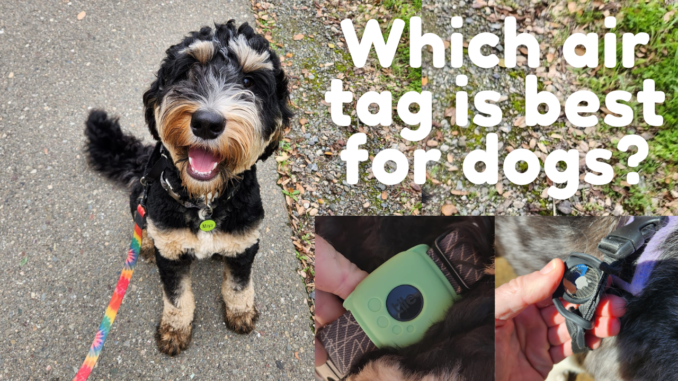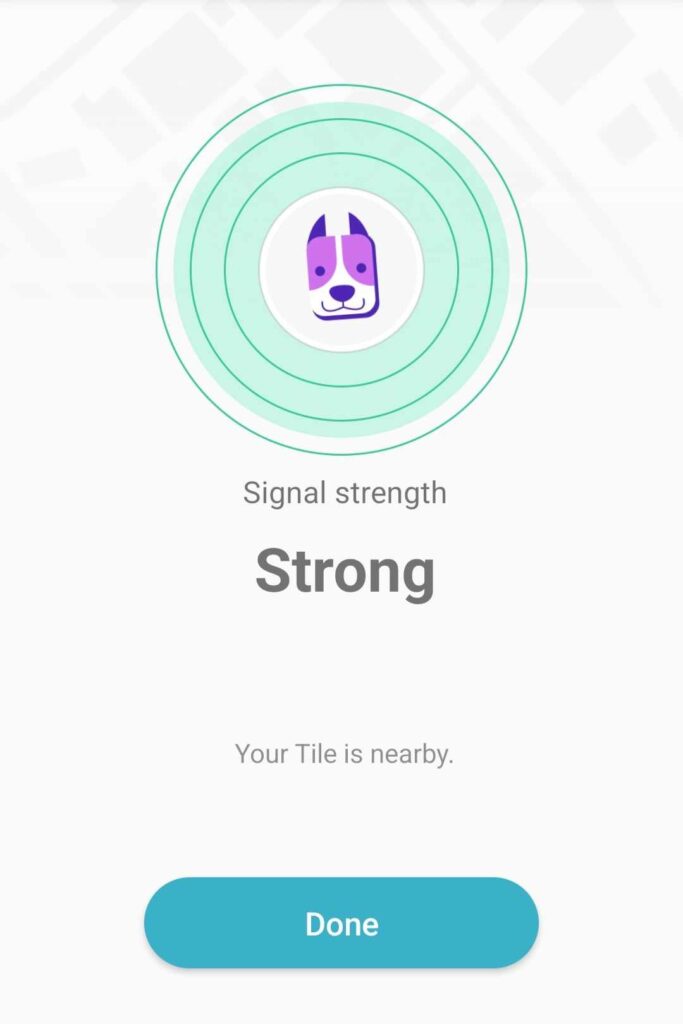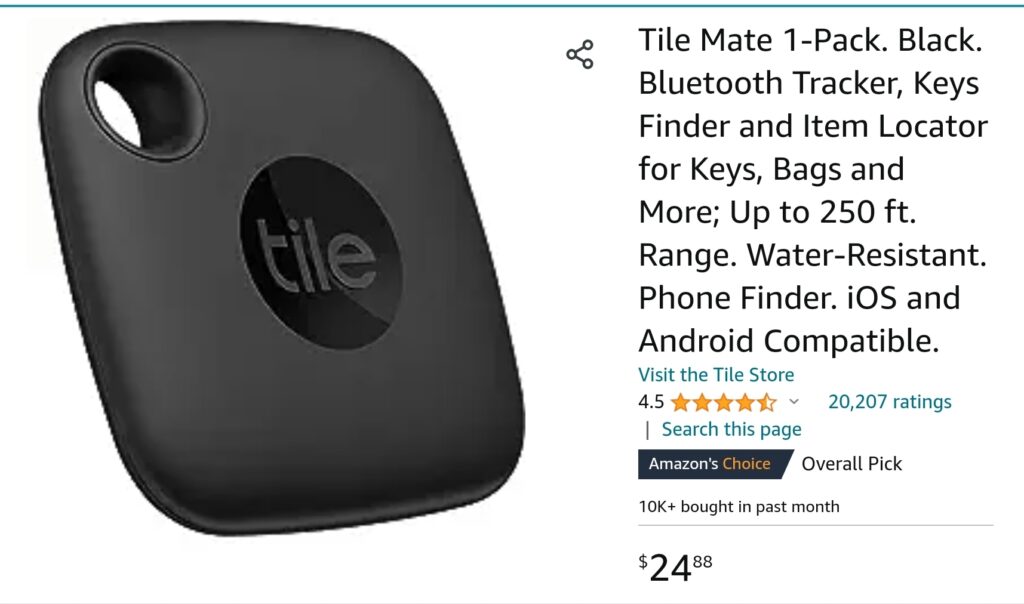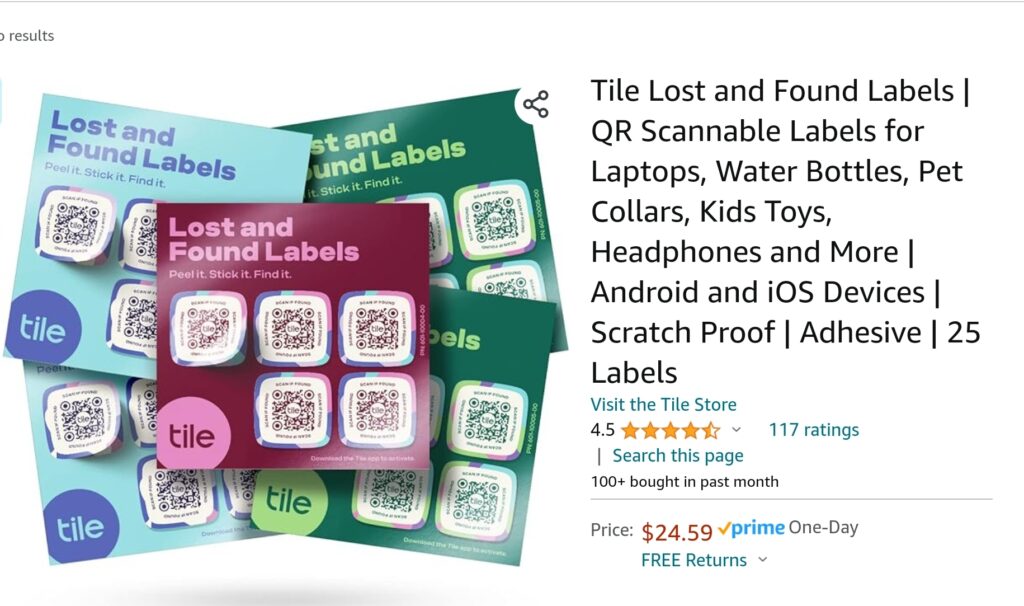
Many dog owners are using air tags as trackers to prevent their dogs from becoming lost. How do these tags work, how effective are they, and which one is best? Here I review the Apple Air Tag, Tile, and iSearching.
What is an air tag?
The Air Tag, also called a Smart Tag or Bluetooth Tracker, is a small battery-operated device used to locate lost items. It works using a Bluetooth Low Energy (BLE) and Ultra Wideband (UWB) signal to connect with nearby mobile phones and tablets.
Because air tags do not have GPS, the drain on the battery is very little. They do not need to be charged. According to manufacturers they should run on one battery for up to a year.
Air tags are inexpensive, usually costing around $25 or less if purchased in multi-packs. Because they are so low-cost with long battery life, air tags are becoming popular with pet owners as an alternative to GPS collars which can cost over $100 plus a monthly subscription and need to be charged often.
How do air tags work?
Air tags emit a signal which can be picked up by nearby mobile phones and tablets. When you purchase your tags you will pair them with your mobile devices for ease in finding the items (or pets) they are attached to. Common uses for these tags include wallets, luggage, kids’ bicycles, and anything else which might be misplaced or stolen.
When you are missing an item attached to the tag, you activate the “find” command in the app used to manage your tag. Your phone will show you how close you are to the tag with a visual or audio cue. It’s kind of like the “hot and cold” game you played as a kid. Walk closer to the tag, the beep gets louder. Walk away, it gets lower.
One of the limitations of these tags is the signal range. According to manufacturers’ specs this can be anywhere from 25-250 feet. So this is fine for locating something in the house or backyard, but if your dog runs away how does that work?

When the tag is out of range of your mobile devices, it will ping off of other people’s phones when they pass within range. They won’t be aware that this is happening and they don’t need to have the app installed. You won’t know who they are and they won’t know who you are. Although privacy is protected, it is kind of weird to think that mobile phone and app companies can access our locations and other information at any time. I imagine these are the things we agree to when we click on the Terms and Conditions box without reading them!
As you can imagine, this feature works best in a metro area with many people and phones. If you live in a rural area or your dog runs away into the woods it won’t be very effective.
Most of these tags have other cool features. For example, when paired you can push the button on the tag and it will cause your phone to beep. That’s handy if you left it in the bathroom or if it fell between the couch cushions! You can also use the tag to take selfies. This is handy if you want to put your phone on a tripod or just prop it up farther away, and you don’t want to have to run back into the frame within the 10 seconds provided by the camera’s selfie timer.
Different brands
For this article and video I purchased three different kinds of tags: the most well-known Apple Air Tag, the Android alternative Tile, and a cheap one selected randomly on Amazon. As with other products I test and review, I like to pick a no-name inexpensive one to see how different – or not – it is from the name brands.
When deciding which is best, I look at effectiveness, ease of use, and price.
Apple Air Tag
The Apple Air Tag costs around $25 and can be purchased in Apple stores, in many other shops, and of course online. Setup is simple using the Find My app on your phone or iPad. Note that the air tag only works on Apple devices. We’ll get to those compatible with Android in a minute.

No subscription is required for the air tag so your only expense is the initial purchase plus battery replacement once a year or so.
I gave this tag to a friend to test since I don’t use iPhone. She said setup was relatively easy. The tag is managed with the Find My app which comes with every iPhone. The tag had to be Bluetooth connected to her phone to work. You can give the tag a name like wallet, keys, etc. so she named it Dash after her dog. She put the tag on her dog with a rubber collar keeper I bought on Amazon. There are many accessories to choose from to attach the air tag to a collar, harness, or whatever.

The first issue she encountered was that the tag would not pair with her husband’s phone. They believe this is because it is an older phone and not compatible with the latest air tag. The next thing she discovered was that, when her husband took the dogs for a walk and she stayed home, she did not get pinged with their location. We thought this would happen automatically, but upon further investigation it seems you have to activate the “lost” mode and enable notifications for this to work.
I saw some videos on YouTube of folks doing a sort of geocaching exercise with air tags. They would hide them in different places and find them later. This gave me the idea to do the same and see how many pings I get for each tag. I picked two places, my grooming shop downtown and a walking path near my home. I’m not exactly in a metro area, but enough people pass by these locations to make geolocation a possibility.
It didn’t take long to get a ping on the walking trail, even on a rainy day. Same with the downtown location. Each time my friend received a notification that the tag had been found with a pin on the map. It seems even in a less-populated area there were enough iPhone users within Bluetooth range to activate the tag.
Funny story. I hid the tag under a distinctive sign at the park. When I returned to collect it it was gone! We thought someone took it or an animal ran off with it. It isn’t unheard-of for crows and foxes to create caches of their own of shiny interesting objects. This was an appropriate problem for a tracking device, so we followed the pin on the map to find it. I couldn’t get a visual so my friend joined me with her phone and right away the tag started beeping. Lo and behold, it was under the sign right where I put it … just a different sign!
The main benefit I see with this tag is the sheer number of iPhone users. The tag is supposed to ping off of any iPhone, the user does not have to have tags themselves or any special app installed for this purpose.
Tile
Tile is one of the name-brand smart tags compatible with Android. It can also be used with Apple. Setup is simple with the Tile app. You can also manage your Tile tags with Alexa, Hey Google, or Siri. The basic service is included with the purchase price. There is an optional subscription for premium services like smart alerts, 30-day location history, and item reimbursement if Tile fails to locate a lost item.

Unlike the Apple air tag, the Tile comes in different versions and shapes including the classic disc, flat credit-card shape, and button-shaped sticker. This variety increases the tracker’s usefulness for different situations.
The Tile Mate, the one I purchased, has a 3-year battery that is not replaceable. The unit is sealed so when it stops working you need to buy another one. With a purchase price around $25 that’s not too bad of a deal for three years.
The unit is supposed to work up to 250 feet from a paired device like your phone. One neat feature of the tag is a QR code printed on the back that works just like a QR code pet ID tag. If someone finds your Tile and whatever it’s attached to, they can scan the QR code to notify you. You can also order additional QR labels which you can attach to anything like your laptop or briefcase.

The Tile Mate is a relatively small square so is an appropriate size for at least my big dog. I don’t know how clunky it would be on a smaller dog. There are many collar attachments available for purchase, but the Tile Mate has a hole so can be attached to your dog’s collar with a split ring like any other ID tag. I attached it to my dog Maya’s collar with a rubber keeper for the test run.
When you download the app it asks what you are using the tag for and you can select “Dog.” I found it to be accurate in close range around the house or yard. You click on the dog icon and the phone beeps and shows a message like “moderate” “strong” and “very strong.”
I tested it as “lost” in two places as I did with the Apple air tag, my grooming shop and a nearby walking path. The results are in, and they aren’t good! I got no pings from my shop which is right downtown. It’s a little set back from the main street so might not be in Bluetooth range of too many people, although some people come in throughout the day to patronize the businesses. I got only one ping from the walking path which sees quite a few people walk right by every day. It was on a Sunday, so only one person with the Tile app installed passed by my hidden tag.
The biggest limitation of the Tile is that it can only ping phones with the Tile app installed. The company claims to have 40 million users but it’s unclear where they all are. I was unable to determine how many Tile users are in my area although other users were able to do so. I’m not sure if it’s because I don’t have the Premium subscription or if I have a different version of the app.
iSearching
I purchased a pack of cheap trackers to see how they measured up to the name brands. Well, I got what I paid for. To use these trackers you need to download the iSearching app. I did so and couldn’t make heads or tails of it. I watched videos on Amazon of users happily setting up their tags, but I couldn’t get them to work at all. I was able to pair a tag at one point and do a bit of testing, then the app froze up and I could do no more.
The first thing I discovered is that these tags do not ping off of other people’s phones. They are simply a Bluetooth device connected to your phone. I put one in my kitchen then left the house and walked across the street. I got a notification that the unit was out of range with a pin on the map of the last known location, my house. I already knew that, so it wasn’t so helpful. Apparently there is a way to make it beep so you can find it, but I wasn’t able to make that work.
While these cheap tags may work for some people, at least for items around the house, my experience was not positive so I wouldn’t recommend them. They definitely would not be useful as dog ID because as soon as your dog is out of Bluetooth range you have no way of tracking them.
Conclusion
Because smart tags work via crowdsourcing, they can be effective in a metro area. In a smaller town or more rural area without many phones around within Bluetooth range, they might not work at all. The easy winner is the Apple air tag. Because so many people use iPhones and the device will ping off of all of them, this unit — and your dog — has the best chance of being located.
That said, air tags are not the best form of dog ID in my opinion. A QR code tag or old fashioned engraved tag with your phone number are very effective. If you want to track your dog a GPS collar is a better option. Stay tuned for my article and video on that subject!

